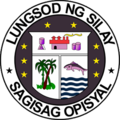Silay | |
|---|---|
| City of Silay | |
 | |
| Nicknames: "The Paris of Negros" "The Visayan Marseille" | |
| Anthem: Silaynon Song | |
 Map of Negros Occidental with Silay highlighted | |
Location within the Philippines | |
| Coordinates: 10°48′N122°58′E / 10.8°N 122.97°E | |
| Country | Philippines |
| Region | Negros Island Region |
| Province | Negros Occidental |
| District | 3rd district |
| Founded | 1565 |
| Cityhood | June 12, 1957 |
| Named after | Cratoxylum sumatranum (locally called Kansilay) |
| Barangays | 16 (see Barangays) |
| Government | |
| • Type | Sangguniang Panlungsod |
| • Mayor | Joedith C. Gallego |
| • Vice Mayor | Thomas Maynard J. Ledesma (Ind) |
| • Representative | Javier Miguel L. Benitez (PFP) |
| • City Council | Members |
| • Electorate | 90,213 voters (2025) |
| Area | |
• Total | 214.80 km2 (82.93 sq mi) |
| Elevation | 57 m (187 ft) |
| Highest elevation | 1,398 m (4,587 ft) |
| Lowest elevation | 0 m (0 ft) |
| Population (2024 census) [3] | |
• Total | 136,802 |
| • Density | 636.88/km2 (1,649.5/sq mi) |
| • Households | 32,693 |
| Demonym | Silaynon |
| Economy | |
| • Income class | 3rd city income class |
| • Poverty incidence | 16.29 |
| • Revenue | ₱ 1,186 million (2022) |
| • Assets | ₱ 1,628 million (2022) |
| • Expenditure | ₱ 979.9 million (2022) |
| • Liabilities | ₱ 552.9 million (2022) |
| Service provider | |
| • Electricity | Negros Electric and Power Corporation (NEPC) |
| Time zone | UTC+8 (PST) |
| ZIP code | 6116, 6117 (Silay Hawaiian Central) |
| PSGC | |
| IDD : area code | +63 (0)34 |
| Native languages | Hiligaynon Tagalog |
| Website | www |
Silay, officially the City of Silay (Hiligaynon : Dakbanwa/Syudad sang Silay; Filipino : Lungsod ng Silay), is a component city in the province of Negros Occidental, Philippines. According to the 2024 census, it has a population of 136,802 people. [5]
Contents
- Etymology
- The Legend of Princess Kansilay
- History
- Spanish colonization
- Negros Revolution
- World War II
- Post-World War II
- Culture
- Kabataang Silay Ensemble Rondalla
- Hugyaw Kansilay Festival
- Geography
- Barangays
- Climate
- Demographics
- Economy
- Negros Occidental Convention Center
- Transportation
- Airports
- Education
- Public schools
- High schools
- Private schools
- Gallery
- Sister cities
- Local
- International
- Notable people
- See also
- References
- External links
Silay is often referred to as the "Paris of Negros" [6] due to its artists, cultural shows and large collection of perfectly preserved heritage houses. More than thirty of these houses have been declared by the National Historical Commission of the Philippines as part of the Silay National Historical Landmark. [7] [8] In 2015, the city celebrated its 58th charter anniversary. [9]



















